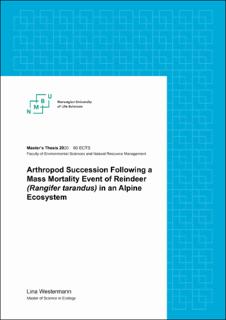| dc.description.abstract | Carcasses are of great ecological importance, especially as a resource for arthropods. However, many aspects of carrion ecology remain to be investigated. One of these aspects is the ecological significance of mass mortality events. In 2016, a natural mass mortality event gave the opportunity for an extensive study on carcass decomposition in an alpine area, as a lightning strike killed 323 wild reindeer (Rangifer tarandus) at the Hardangervidda mountain plateau in Norway. Two years after the incident, when the reindeer were in the dry/remains stage, twice as many arthropods were found on the site where the reindeer died as on a control site 300 m away. In this study, I investigated how much the arthropod activity changed from the second year after mass death to the third. This included examining both large-scale effects – the differences between the carrion site and the control site, and small-scale effects – the differences along a carrion density gradient on the carrion site. Three years after the mass death, the number of arthropods on the carrion site was still significantly higher than on the control site. The positive response to carcass presence was found in several different groups: Predators, parasitoids, detritivores, Diptera, springtails and mites. Among the Diptera, Parapiophila vulgaris was particularly favoured numerically by the presence of carcasses. On the small scale, parasitoids, detritivores and springtails were positively correlated with carrion density. There was no decline in arthropod activity on the carrion site from the second year to the third. My study therefore shows that the large arthropod abundance the second year after the mass mortality event at Hardangervidda was maintained the third year. The large and long-lasting impact the carcasses had on the arthropod abundance is a clear sign that carrion needs to be recognized as an important element of biodiversity and biomass production in ecosystems. | en_US |

